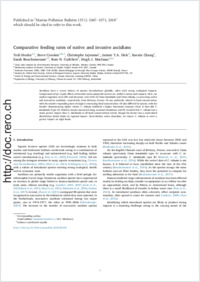Comparative feeding rates of native and invasive ascidians
- Hoxha, Tedi Great Lakes Institute for Environmental Research, University of Windsor, Canada
- Crookes, Steve Great Lakes Institute for Environmental Research, University of Windsor, Canada - Biodiversity Institute of Ontario, University of Guelph, Canada
- Lejeusne, Christophe Station Biologique de Roscoff, France
- Dick, Jaimie T. A. Institute for Global Food Security, School of Biological Sciences, Queen's University Belfast, UK
- Chang, Xuexiu School of Ecology and Environmental Sciences, Yunnan University, Kunming, China
- Bouchemousse, Sarah Station Biologique de Roscoff, France - Department of Biology, University of Fribourg, Switzerland
- Cuthbert, Ross N. Institute for Global Food Security, School of Biological Sciences, Queen's University Belfast, UK
- MacIsaac, Hugh J. Great Lakes Institute for Environmental Research, University of Windsor, Canada - School of Ecology and Environmental Sciences, Yunnan University, Kunming, China
-
01.10.2018
Published in:
- Marine Pollution Bulletin. - 2018, vol. 135, p. 1067–1071
French
Ascidians have a recent history of species introductions globally, often with strong ecological impacts. Comparisons of per capita effects of invaders and comparable natives are useful to assess such impacts. Here, we explore ingestion rates (IR) and clearance rates (CR) of Ciona intestinalis and Ciona robusta, co-occurring native and non-native ascidians, respectively, from Brittany, France. IR was positively related to food concentration, with the invader responding more strongly to increasing food concentration. CR also differed by species, with the invader demonstrating higher values. C. robusta exhibited a higher functional response (Type I) than did C. intestinalis (Type II). Relative impact measured using seasonal abundance and IR revealed that C. robusta has a much greater impact than C. intestinalis at all food concentrations tested, though the former has a constrained distribution which limits its regional impact. Nevertheless, when abundant, we expect C. robusta to exert a greater impact on algal foods.
- Faculty
- Faculté des sciences et de médecine
- Department
- Département de Biologie
- Language
-
- English
- Classification
- Biological sciences
- License
-
License undefined
- Identifiers
-
- RERO DOC 323276
- DOI 10.1016/j.marpolbul.2018.08.039
- Persistent URL
- https://folia.unifr.ch/unifr/documents/306986
Statistics
Document views: 102
File downloads:
- pdf: 163
